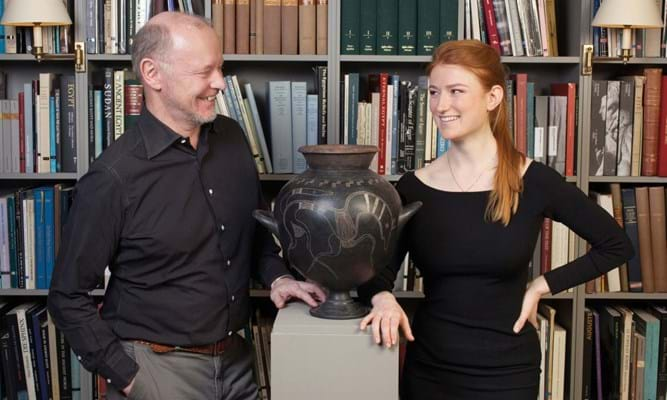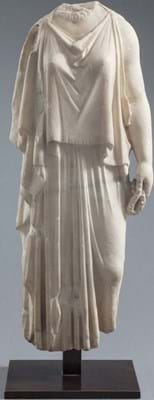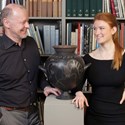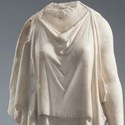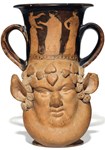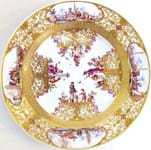In the book-lined back room of London antiquities dealership Charles Ede sit its two new directors: Martin Clist and Charis Tyndall.
And they are discussing the state of the market with reference to a rather more recent innovation: emojis, aka electronic messaging symbols.
Greek black and red-figure vases might be among the less popular pieces for buyers at the moment, but could this popular technology point to a comeback inspired by the ‘new world’?
“When you think about antiquities you think at once of Greek vases,” Clist says. “In fact, it’s one of the picture symbols that come with your iPhone. How often that gets used I don’t know, but it’s jolly interesting that the amphora in itself is still part of our cultural reference, which could mean museums or an archaeological site.”
The directors give an impression of being dialled into both the antiquities trade and the face it presents to the wider, modern world.
Clist has years of experience working in contemporary art and Tyndall is one of the youngest members – not to mention leaders – of the trade.
They make an energetic team, enthusiastic and talkative, talking over each other as they describe individual pieces, their experience in the business and their hopes for the trade. In a world where the antiquities market has come under fire and collecting is increasingly tied to the modern and contemporary market, having these two at the helm seems a canny strategy for a traditional dealership.
Step change
The directorship of Clist (58) and Tyndall (27) is a step change for the 46-year-old business which was always previously in family hands. Charles Ede (1921-2002) opened the gallery in Brook Street in 1971 and his son James took over the daily running of it in 1986. Tyndall started at the gallery as a summer job during her studies in classical archaeology and ancient history at the University of Warwick, and came on board officially in 2013.
Then in 2014, James approached Clist with a view to eventually passing him the reins. Clist took on the role of managing director as the second-generation dealer took a step back from (though by no means out of) the daily running.
Early this year Tyndall was appointed to assist Clist with the direction of the business.
The role has its challenges. For Tyndall, getting a foothold in the traditional, male-dominated world of antiquities dealers has been difficult, even with the weight of the company name behind her.
At fairs and even in the gallery, she says, “people assumed that I wasn’t the specialist. They wanted to go find the ‘boss man’ and confer with him”.
Now clients and other dealers know her, but for other women her age starting out, being taken seriously can be testing even in 2017. “The world is changing faster than the industry,” she adds.
On the bright side, conditions which to other, more seasoned antiquities dealers might seem onerous – increased levels of paperwork, more intensive vetting process – are as much a part of the job to Tyndall as the research and design.
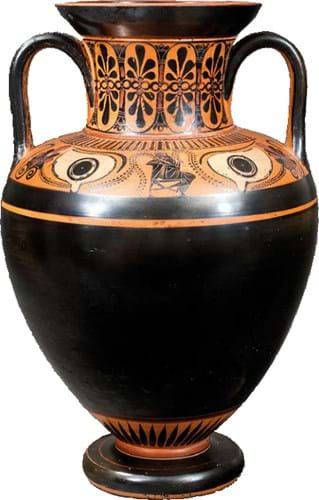
This Greek terracotta black-figure eye amphora comes from Athens, c.530-520BC. It is offered for £149,000 by Charles Ede. Photo courtesy of Charles Ede.
Strong foundation
As for Clist, even four years in he admits: “I’m still getting to grips with what determines and shapes what Charles Ede stands for. I don’t want to get rid of the foundation.”
One of his earliest responsibilities once on board was setting up the gallery’s new space in Three King’s Yard in 2014. While he is keen to preserve its reputation for offering well-researched, reputable objects, “at the same time I wanted to bring in a look that was a bit cleaner”.
Clist’s first job with antiquities was at fellow London dealer Rupert Wace in 1992 (a role sandwiched between positions at the Waddington Galleries and Rossi & Rossi). He recalls the image of antiquities dealerships at the time was associated with “grand tour, great houses, gold curly-whirly writing, deep-buttoned upholstery, fustiness, with unreconstructed museums”.
His desire to overturn this image persists. Clist’s designs both for the gallery and its fair stands spotlight individual pieces against a stripped-back interior. Collectors who might normally focus on contemporary art can browse the gallery, envisaging these pieces in the cool interior of a contemporary home. It is not unknown for a client to purchase an object along with the plinth used to exhibit it.
According to Clist, these buyers “don’t want to know the name of every Egyptian god, but if they see a Corinthian helmet with an almost minimalist form, it uplifts them”.
Nowhere is the synthesis between ancient and modern made more evident at the moment than at TEFAF New York Spring, which had its inaugural edition in May. The event featured specialists in both areas – the appeal of Charles Ede writ large.
Among its sales was the stand highlight, a Falliscan olla with a horse (shown in the main photo above) incised on each side and a Greek Tarantine limestone statue of a muse, both of which went to new clients for six-figure sums.
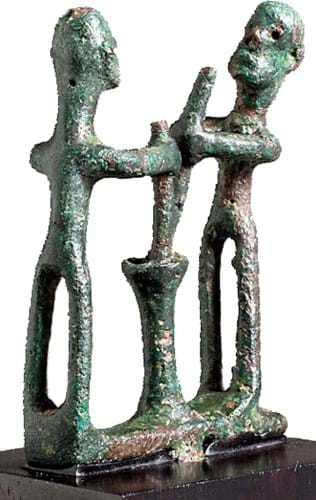
This Italic bronze figural group dates to the first half of the 1st millennium BC. It was sold to the Michael C Carlos Museum in Atlanta, USA, earlier this year. Photo courtesy of Charles Ede.
Dash of drama
But what does this style of cross-collecting mean to Tyndall? She speaks passionately about the objects that come through the gallery and admits that it can be “heart wrenching” to sell pieces that have become particular favourites.
Does it rankle when a piece she has researched, sometimes for years, goes to the collector who, perhaps, wants a piece to add a dash of drama to an amalgam of contemporary painting? Not so, she insists.
“Everything appeals to someone for a different reason and who am I to judge?” she says. “And anyway, sometimes we come across objects that are not interesting in terms of historical value but I think ‘Oh, isn’t it beautiful’. Just to have it and hold it is part of the joy.”
Three is as many fairs as the gallery can handle reasonably. Between its long-running loyalty to Maastricht – its most successful annual event – and enthusiasm for the two New York events, there was no room for this week’s Masterpiece London.
They support holding such an event in London and have exhibited there in previous years. But, as Clist puts it, “there are more billionaires in New York than the rest of the world. These fairs are successful for us”. And, Tyndall adds, “TEFAF is such a strong brand,” and to have it providing a vehicle for their developing brand makes it ideal.
Soon the traditional business could be pushed even further with an exhibition offering antiquities alongside contemporary at Charles Ede’s Three Kings’ Yard gallery.
“Every year I think, ‘Is this the right moment for us to do this?’” Clist says.
It would be a collaboration with a contemporary specialist – talks have been held with one New York dealer. The challenge, he reflects, would be finding contemporary art that merited a place alongside objects of the quality Charles Ede offers.
Tyndall adds that the gallery is not about to start dealing in contemporary art: “The Classical world covers 3000 years of history. That’s big enough to be getting on with.”
“I don’t want it to be seen as a watering down of the brand,” Clist says. “We have a history of dealing with wonderful things and that is something I want to continue.”


